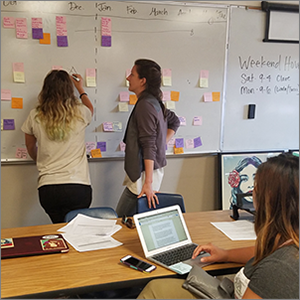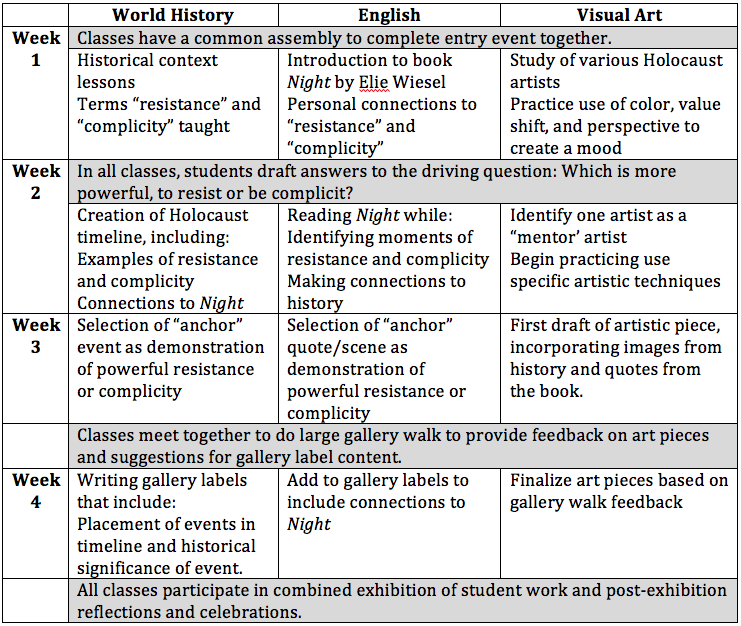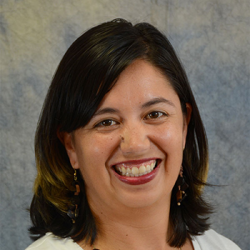
Interdisciplinary, or multi-subject, projects are often seen as the pinnacle of PBL goodness. They give students the opportunity to dive more deeply into content, make connections between subject areas, see examples of positive collaboration between their teachers, and spend more time on a project. They are also a lot of work to plan. My key to success in planning interdisciplinary projects has been to start early. So, with the new school year ahead, now is the perfect time to jump right in! Read on to find solutions to common interdisciplinary pitfalls.
Pitfall #1: Becoming the “Dessert” Subject
It is really easy to have an interdisciplinary project that is really a “main course” substantial project in one class, but becomes a “dessert” project in other classes. For example, an English class may have students write a poem for the project that isn’t related to the content they’re teaching or a math project might calculate something once related to the project topic.
To avoid this, ensure that all subject areas involved have deep, meaningful content related to the project. If you find yourself forcing a connection, then it is better to not join the project. Otherwise, you’ll find yourself adding the project to your class in an artificial way, and students will likely struggle to see authentic, meaningful connections in their work. I have participated in rich projects that incorporated visual art deeply, connecting themes and utilizing important artistic skills. I have also seen art tacked as a pretty addition to real learning in other classes in a way that devalues art as its own, meaningful subject. If it wouldn’t be a meaningful project on its own in your own class, then perhaps it is not “main course” enough to be part of an interdisciplinary project.
Pitfall #2: Out of Sync Classes and Missed Opportunities
It is really easy to get deep into your own curriculum and realize halfway through a project that a substantial, interesting connection could have been made with a project happening two weeks later next door. My advice is to plan together early and often.
At Impact Academy of Arts and Technology, an Envision School, staff starts the year with a long grade-level planning session. In this session, teachers map their course on a white board using sticky notes and showing driving questions, main content, and possible product ideas for each project. This allows teachers to visually see where natural interdisciplinary collaboration could occur, move around their projects to allow for more collaboration, and make sure students won’t have five projects all due at the same time! (See this video of a similar process used at High Tech High.)
Once an opportunity for interdisciplinary work has been identified, it’s important to plan together early and often. School leaders: make time for this! You get many benefits as a result; novice teachers learning and planning with veteran teachers inherently improves the quality of instruction in their classroom, teachers build community with each other, and students learn content and skills more deeply.
Pitfall #3: Students Miss the Connection
I have, very tragically, finished an “interdisciplinary project” only to have students say, on the last day, “Wait a minute…weren’t we talking about the same thing in English class?!” I could not believe they had moved through the project without realizing this earlier! But really, without a shared product, any co-teaching, or real authentic collaboration between subjects, how could they have gotten that connection?
There are a few ways to avoid this. First, launch the project together. Do the tough work of combining classes, planning an assembly, or trading rooms for a day so students see all teachers involved talking about the same thing in the same room. Second, actively use work done in the other classes in your own room. Do peer critique in your class about a product created in another class. Use the same materials and have common texts, pictures, and other artifacts visible in both classes. Finally, and perhaps most obviously, finish the project together. Share in the exhibition, assess work together, have students reflect across subject-areas, explicitly noting the ways they deepened their knowledge through interdisciplinary work.
Sample Interdisciplinary Project Calendar
Driving Question: In times of extreme oppression, is it more powerful to resist or be complicit?
Classes Involved: World History, English, Visual Art
Public Product: Activist art piece with museum-quality gallery labels

Want to learn more about PBL? Check out our books.

